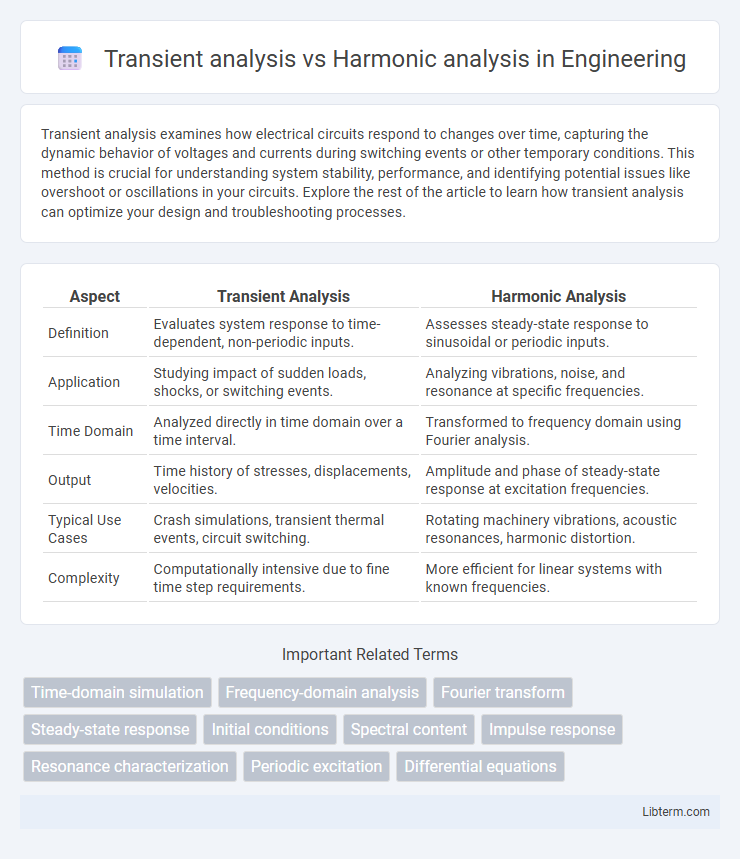Transient analysis examines how electrical circuits respond to changes over time, capturing the dynamic behavior of voltages and currents during switching events or other temporary conditions. This method is crucial for understanding system stability, performance, and identifying potential issues like overshoot or oscillations in your circuits. Explore the rest of the article to learn how transient analysis can optimize your design and troubleshooting processes.
Table of Comparison
| Aspect | Transient Analysis | Harmonic Analysis |
|---|---|---|
| Definition | Evaluates system response to time-dependent, non-periodic inputs. | Assesses steady-state response to sinusoidal or periodic inputs. |
| Application | Studying impact of sudden loads, shocks, or switching events. | Analyzing vibrations, noise, and resonance at specific frequencies. |
| Time Domain | Analyzed directly in time domain over a time interval. | Transformed to frequency domain using Fourier analysis. |
| Output | Time history of stresses, displacements, velocities. | Amplitude and phase of steady-state response at excitation frequencies. |
| Typical Use Cases | Crash simulations, transient thermal events, circuit switching. | Rotating machinery vibrations, acoustic resonances, harmonic distortion. |
| Complexity | Computationally intensive due to fine time step requirements. | More efficient for linear systems with known frequencies. |
Introduction to Transient and Harmonic Analysis
Transient analysis examines circuit behavior over time by simulating the response to time-varying signals or sudden changes, capturing non-steady-state phenomena such as switching events or pulse responses. Harmonic analysis focuses on steady-state sinusoidal signals, decomposing complex waveforms into fundamental and harmonic frequencies to evaluate frequency-domain characteristics like distortion and impedance. Both analyses are essential for comprehensive assessment of electronic and power systems, addressing time-dependent dynamics and frequency-based effects respectively.
Defining Transient Analysis
Transient analysis studies circuits' time-dependent responses to sudden changes in inputs, capturing voltage and current waveforms over time after switching events. It models non-steady state behavior, such as capacitor charging or inductor flux variation, essential for understanding signal propagation and transient phenomena. Harmonic analysis, in contrast, examines steady-state sinusoidal responses by decomposing signals into their frequency components to assess distortion and resonance effects.
Understanding Harmonic Analysis
Harmonic analysis examines steady-state response of electrical circuits to sinusoidal inputs by decomposing signals into fundamental frequencies and their harmonics, revealing circuit behavior under periodic excitation. It provides insights into voltage, current phasors, power factor, and distortion levels critical for designing filters, amplifiers, and power systems. Unlike transient analysis, which studies time-domain responses to sudden changes, harmonic analysis focuses on frequency-domain characteristics essential for optimizing system performance and mitigating harmonic distortion.
Key Differences Between Transient and Harmonic Analysis
Harmonic analysis examines steady-state response of electrical circuits to sinusoidal inputs by decomposing signals into fundamental frequencies and their harmonics, revealing circuit behavior under periodic excitation. It provides insights into voltage, current phasors, power factor, and distortion levels critical for designing filters, amplifiers, and power systems. Unlike transient analysis, which studies time-domain responses to sudden changes, harmonic analysis focuses on frequency-domain characteristics essential for optimizing system performance and mitigating harmonic distortion.
Applications of Transient Analysis
Harmonic analysis examines steady-state response of electrical circuits to sinusoidal inputs by decomposing signals into fundamental frequencies and their harmonics, revealing circuit behavior under periodic excitation. It provides insights into voltage, current phasors, power factor, and distortion levels critical for designing filters, amplifiers, and power systems. Unlike transient analysis, which studies time-domain responses to sudden changes, harmonic analysis focuses on frequency-domain characteristics essential for optimizing system performance and mitigating harmonic distortion.
Applications of Harmonic Analysis
Harmonic analysis examines steady-state response of electrical circuits to sinusoidal inputs by decomposing signals into fundamental frequencies and their harmonics, revealing circuit behavior under periodic excitation. It provides insights into voltage, current phasors, power factor, and distortion levels critical for designing filters, amplifiers, and power systems. Unlike transient analysis, which studies time-domain responses to sudden changes, harmonic analysis focuses on frequency-domain characteristics essential for optimizing system performance and mitigating harmonic distortion.
Advantages of Transient Analysis
Harmonic analysis examines steady-state response of electrical circuits to sinusoidal inputs by decomposing signals into fundamental frequencies and their harmonics, revealing circuit behavior under periodic excitation. It provides insights into voltage, current phasors, power factor, and distortion levels critical for designing filters, amplifiers, and power systems. Unlike transient analysis, which studies time-domain responses to sudden changes, harmonic analysis focuses on frequency-domain characteristics essential for optimizing system performance and mitigating harmonic distortion.
Benefits of Harmonic Analysis
Harmonic analysis excels in accurately identifying steady-state frequency components in electrical systems, enabling precise diagnosis of power quality issues such as harmonics distortion and resonance problems. This method enhances the design and optimization of filters, transformers, and other equipment by providing detailed insights into the amplitude and phase of each harmonic frequency. Compared to transient analysis, which focuses on time-domain signals and short-term disturbances, harmonic analysis offers the advantage of optimizing system performance under normal operating conditions through frequency-domain evaluation.
Choosing the Right Analysis for Your Project
Transient analysis simulates a circuit's response over time, making it essential for studying non-steady-state signals, switching events, and time-dependent behaviors in power electronics or signal processing applications. Harmonic analysis evaluates steady-state sinusoidal responses at different frequencies, ideal for analyzing distortion, resonance, and frequency-dependent performance in RF circuits or AC power systems. Selecting the right analysis depends on project goals: use transient analysis for time-domain dynamics and harmonic analysis for frequency-domain characterization.
Conclusion: Transient vs Harmonic Analysis
Harmonic analysis examines steady-state response of electrical circuits to sinusoidal inputs by decomposing signals into fundamental frequencies and their harmonics, revealing circuit behavior under periodic excitation. It provides insights into voltage, current phasors, power factor, and distortion levels critical for designing filters, amplifiers, and power systems. Unlike transient analysis, which studies time-domain responses to sudden changes, harmonic analysis focuses on frequency-domain characteristics essential for optimizing system performance and mitigating harmonic distortion.
Transient analysis Infographic

 libterm.com
libterm.com